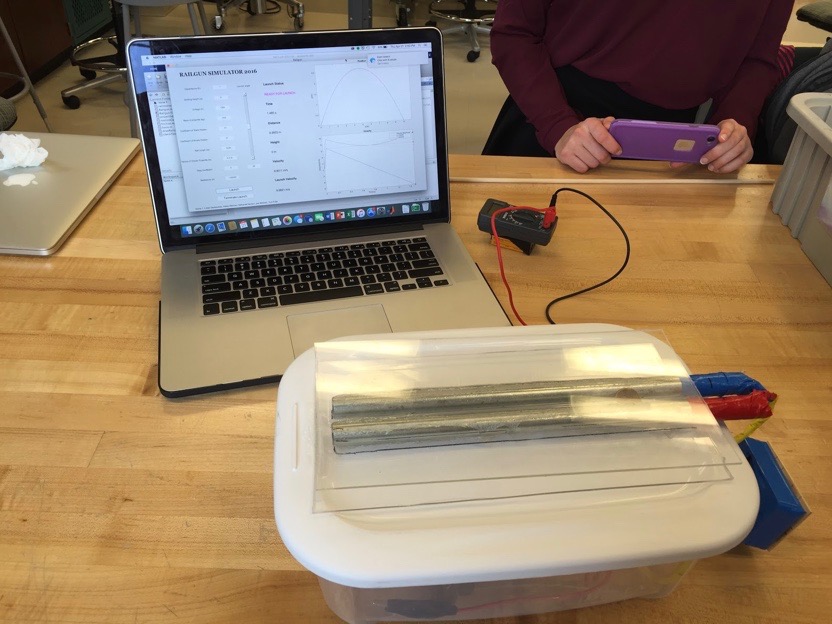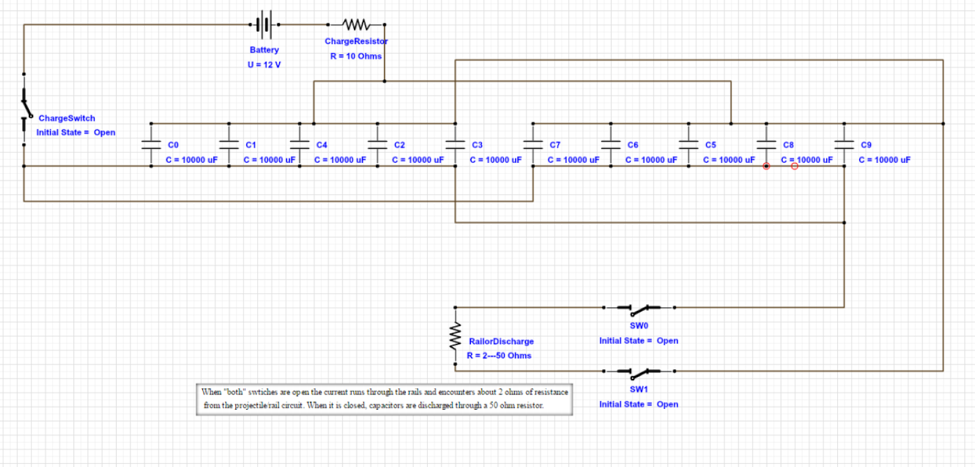Railgun
 A railgun is a weapon currently being researched by the United States Navy that uses an electrical current to create a magnetic field that launches a projectile. The magnetic field creates a Lorentz force on the projectile because the projectile is a part of the circuit and thus it can be treated like a moving charged particle. In order to create a Lorentz force large enough to launch a projectile, the starting energy – stored in capacitors – must be very high and must discharge in a very short period of time to transfer all of the energy successfully to the projectile. To determine the capacitance and voltage necessary to transfer sufficient energy to the projectiles, we used knowledge of physics as well as vector calculus to combine equations such as Maxwell’s equations and Lorentz’s force law.
A railgun is a weapon currently being researched by the United States Navy that uses an electrical current to create a magnetic field that launches a projectile. The magnetic field creates a Lorentz force on the projectile because the projectile is a part of the circuit and thus it can be treated like a moving charged particle. In order to create a Lorentz force large enough to launch a projectile, the starting energy – stored in capacitors – must be very high and must discharge in a very short period of time to transfer all of the energy successfully to the projectile. To determine the capacitance and voltage necessary to transfer sufficient energy to the projectiles, we used knowledge of physics as well as vector calculus to combine equations such as Maxwell’s equations and Lorentz’s force law.

Unfortunately, due to safety concerns, we were limited to a total capacitance of .1 F and a voltage of 12V. These specifications were insufficient to provide an actual launch, but we were able to see a spark when the circuit was completed by the projectile – a penny. With a higher voltage, we may have been able to produce the current necessary to launch a projectile, as we explored in our graphical user interface. Build concepts that we explored in this project included soldering the circuits of the capacitors and breadboard as well as cutting the metal rails and their casing to size.

The GUI for this project provided inputs for nearly all parameters of the build, the only unchangeable aspect was the geometry of the railgun, as our equations were calculated for two parallel rails. After inputting the desired specifications, the user had the option to begin the launch using the “Launch” button. Under this button, we provided a “Terminate Launch” button in order to stop longer simulations from continuing. Immediately after pressing the “Launch” button, the GUI will show the launch status, highlighted in a different color for each status: failed, success, will not exit the rails, or ready for launch. If the launch is a success, or if the projectile will move and not leave the rails, the program will proceed to plot the trajectory and velocities of the projectile in real time using the stopwatch functions within Matlab. Many aspects of programming were explored throughout the project, including the Verlet method and linking functions to a GUI. Using the GUI, we were able to determine various aspects of the project we could have changed had we had access to a greater voltage and capacitance. Overall, while the build side of the project was not successful due to safety constraints, the GUI showed that we were on the right track and could have created a successful railgun with slight modifications.